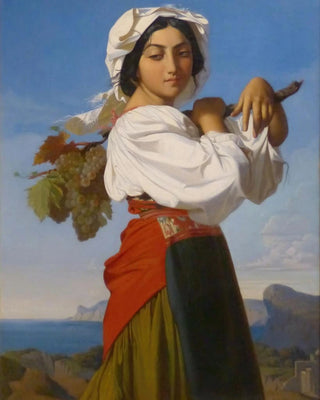Art print | Mariuccia - Henri Lehmann


View from behind

Frame (optional)
In the rich and diverse universe of art history, some artworks manage to capture the very essence of human beauty. "Mariuccia" by Henri Lehmann is one of those iconic pieces that transcend time and eras. Painted in the 19th century, this work not only showcases the undeniable talent of its creator but also the delicate harmony between the subject and the context. By immersing ourselves in this representation, we discover a woman with a deep gaze, a reflection of the human soul, inviting us to explore the mysteries of life and identity.
Style and uniqueness of the artwork
Lehmann's style is characterized by remarkable finesse and meticulous attention to detail. In "Mariuccia," the chosen color palette evokes a softness and warmth that envelop the viewer. The nuances of flesh tones, the light reflections on the skin, and the delicate drapery create an intimate and almost tangible atmosphere. The composition, although classical in structure, reveals a modernity in the expression of the subject. Mariuccia's posture, both natural and posed, demonstrates technical mastery that echoes the art of the great masters of the Renaissance. Observing this work, one feels a powerful emotional connection, an invitation to contemplate beauty in all its forms.
The artist and his influence
Henri Lehmann, born in 1814, established himself as an essential figure in French academic art. A student of Jean-Auguste-Dominique Ingres, he inherited a tradition that values drawing and harmony of colors. His artistic journey is marked by a constant pursuit of perfection, both in technique and in the depiction of human emotions. Lehmann was also a privileged witness to the artistic evolutions of his time, oscillating between neoclassicism and romanticism. His influence extends beyond his own creations, inspiring many artists who followed, while maintaining a unique place in the pantheon of 19th-century masters. Through "Mariuccia," he manages to capture the spirit of his era while offering a timeless vision of femininity.
A decoration

Matte finish

View from behind

Frame (optional)
In the rich and diverse universe of art history, some artworks manage to capture the very essence of human beauty. "Mariuccia" by Henri Lehmann is one of those iconic pieces that transcend time and eras. Painted in the 19th century, this work not only showcases the undeniable talent of its creator but also the delicate harmony between the subject and the context. By immersing ourselves in this representation, we discover a woman with a deep gaze, a reflection of the human soul, inviting us to explore the mysteries of life and identity.
Style and uniqueness of the artwork
Lehmann's style is characterized by remarkable finesse and meticulous attention to detail. In "Mariuccia," the chosen color palette evokes a softness and warmth that envelop the viewer. The nuances of flesh tones, the light reflections on the skin, and the delicate drapery create an intimate and almost tangible atmosphere. The composition, although classical in structure, reveals a modernity in the expression of the subject. Mariuccia's posture, both natural and posed, demonstrates technical mastery that echoes the art of the great masters of the Renaissance. Observing this work, one feels a powerful emotional connection, an invitation to contemplate beauty in all its forms.
The artist and his influence
Henri Lehmann, born in 1814, established himself as an essential figure in French academic art. A student of Jean-Auguste-Dominique Ingres, he inherited a tradition that values drawing and harmony of colors. His artistic journey is marked by a constant pursuit of perfection, both in technique and in the depiction of human emotions. Lehmann was also a privileged witness to the artistic evolutions of his time, oscillating between neoclassicism and romanticism. His influence extends beyond his own creations, inspiring many artists who followed, while maintaining a unique place in the pantheon of 19th-century masters. Through "Mariuccia," he manages to capture the spirit of his era while offering a timeless vision of femininity.
A decoration






